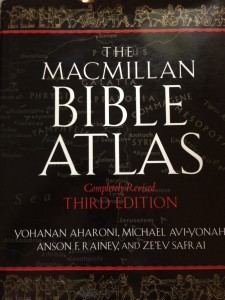Five Archaeology Books Every Christian Should Read
The Bible is not just one book, but sixty-six books composed over a period of around fifteen hundred years. The stories recorded in the Bible are not a myth, but real events recorded by real people who lived in real places in history. This means two things: First, as a science, archaeology can often provide a correlation of those stories with material evidence: that they either happened as the Bible records or that there is no evidence that an event happened as the Bible states. Secondly, since the stories in the Bible are a record of real events in the past, the twin sciences of archaeology and geography become indispensable tools to help us understand the Biblical world and even provide additional evidence that the Bible is a reliable source of valuable historical & geographical information.
Archaeology in the “scientific sense,” has been around since at least the mid-nineteenth century, and there has been much that we have learned about the ancient world since that time.[1] Since it’s been well over a century since archaeologists have been digging in the lands of the Bible, the task of knowing what’s been discovered so far and how archaeology and geography correlates with the Bible can be a bit daunting. The following is a list of five books (with links) that will hopefully provide help to the average person in understanding the value of archaeology in illuminating and affirming the Biblical record.
Note: The following list is only a beginner’s list. It’s intended for those who want to know where to begin a study of Biblical Archaeology (a term that has now been replaced by scholars to the less “offensive” terms, Syrio-Palestinian Archaeology or Near Eastern Archaeology)
A great general overview of the archaeology of the Old Testament organized chronologically, beginning with the Patriarchs in Mesopotamia (a term you should already know), and ending with the Persian exile and the rise of Greece in the Intertestamental Period (the time period between the Old & New Testaments). This is a great book, to begin with! There are illustrations, charts, and maps throughout the book which are very helpful. At the end of each chapter is a great bibliography for further study.
This book is the companion volume to the book listed above. It is organized into four parts which focus primarily on the cultural and political background of the New Testament period. Part 1 – The Architecture of New Testament Times; Part 2 – The Building Program of Herod the Great; Part 3 – Archaeology and the Life of Christ, and Part 4 – Archaeology and the Church. Personally, one of my favorite parts of this book is Chapter 11, ‘The Discovery and Contributions of Ancient Documents,’ which discusses the interaction of ancient historical texts with archaeology.
This is one of my “all-time favorite” books on Ancient Egypt and the Bible! This book by Dr. John Currid provides some amazing and excellent insights into the culture of ancient Egypt. According to the Bible, the Israelites lived in Egypt for 400 years. and the religious culture of Egypt would have had a profound influence over they way that they thought. Since Moses (the traditional author of the Pentateuch) also lived in Egypt, then certainly, there would be evidence in the Biblical text that indicates its authenticity. What is the significance of Moses’ staff becoming a serpent in front of Pharaoh? What do the ten plagues listed in Exodus 7-12 have to do with Egyptian gods and even the pharaoh himself? To find out the answers and learn more about Egypt and the Bible, then read the Old Testament book of Exodus and get Currid’s book.
The fourth book I recommend to beginners in archaeology is also by John Currid. This book is not very long, but it is packed with great information on the history of archaeology and the Bible as well as the science of archaeology. Interspersed throughout the text, are boxes containing archaeological terms with brief definitions – a great tool for newcomers and a refresher to those already familiar with Biblical archaeology. One example of this is “Stratigraphy: the study of the deposition and relationships of the occupational layers of an archaeological site.”[2]
I am a firm believer that every Christian should visit the Holy Land at least once if they are able. If not, the next best thing is to get a very good Bible atlas. I have my library I have several Bible atlases including a two-volume satellite atlas. But there is one atlas that I come back to again and again, and it is the Macmillan Bible Atlas, 3rd Edition. Having excavated in Israel and seeing first-hand how geography is an integral part of the Biblical narrative – a Bible atlas is vital for getting the context of Scripture. Physical geography is also important even in helping identify ancient Biblical sites (such has been the case at least since Edward Robinson in the 1830’s). As the late archaeologist, Yohanan Aharoni wrote: “It is not too much to say that the geographical position of this little land has always dominated its history. Thus, in the land of the Bible, geography, and history are so interwoven that neither can be understood without the other.”[3]
Solomon wrote many centuries ago, “…of the making of many books there is no end, and much study wearies the body” (Eccl. 12:12). I hope this list of books will not weary you, but help in your study of the Bible, and further strengthen your faith & trust in God’s infallible Word.
Notes
[1] For an excellent book on the history of “Biblical Archaeology,” see P.R.S. Moorey’s, A Century of Biblical Archaeology (Louisville, KY: Westminster John Knox Press, 1992).
[2] John D. Currid, Doing Archaeology in the Land of the Bible: A Basic Guide (Grand Rapids: Baker, 1999), p. 28.
[3] The Land of the Bible




Leave a Reply
Want to join the discussion?Feel free to contribute!